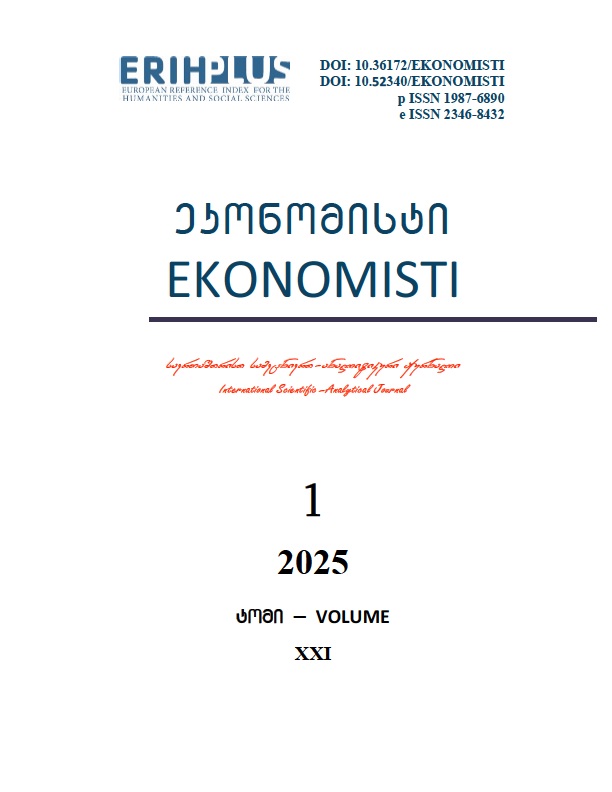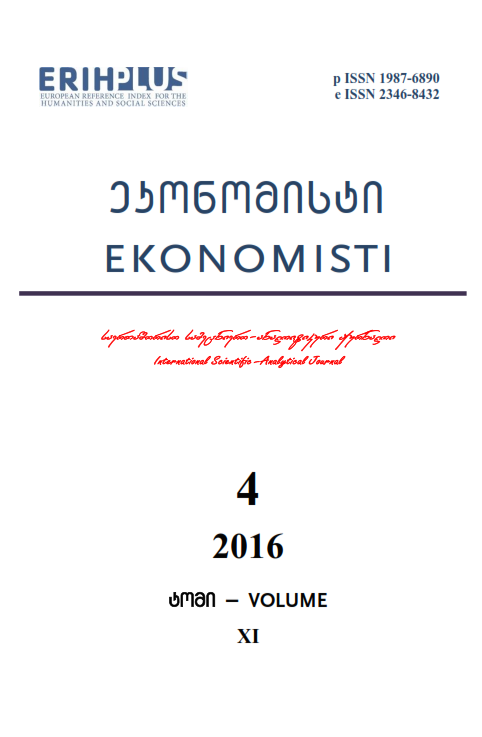
The international scientific and analytical, reviewed, printing and electronic journal of Paata Gugushvili Institute of Economics of Ivane Javakhishvili Tbilisi State University

THE CONCEPTUAL FRAMEWORK OF THE ESTABLISHMENT OF THE MECHANISM FOR STRATEGY OF ECOLOGICAL AND ECONOMIC DEVELOPMENT AND REVITALIZATION OF INDUSTRIAL AREAS IMPLEMENTATION
Summary
In the article, the conceptual approaches of the formation of mechanism implementation of ecological and economic development strategy for industrial and post-industrial territories are defined and grounded. This presupposes the effective interaction of participants of the regional eco-innovative processes aimed at transforming the social and economic environment of the industrial region through ecologization and revitalization of industrial territories and the transition to sustainable management in terms of sustainable development. These principleshave been defined as the basic ones.
Keywords: ecologization, revitalization, the mechanism of strategy implementation, industrial areas, post-industrial areas, sustainable development.
Introduction
Problem statement in general framework.
Connection with scientific and practical objectives.
The adverse environmental conditions in industrial regions require the solution of numerous issues concerning environmental protection and improvement. State environmental policy requires public control, particularly in the use of natural capital of territories.
The current challenges in Ukraine remain as the following: the irregularity of legal regulation mechanisms, low environmental awareness and ecological culture of the population, lack of citizens’ awareness about the environment, ignorance of their environmental rights, which requires the joint efforts of local authorities and government in order to prevent the assumptions for deterioration of the ecological situation in the region. It is a violation of the environmental right to life and use of natural resources in environmentally pleasant conditions [1]. Addressing the most urgent environmental problems can be successful only if initially the clear strategic directions for solving each problem and the most effective mechanisms for achieving those goals are established. The assessment of priorities and risk benefits is an essential prerequisite for investment direction in order to support the significant social and environmentally important tasks of the territories development, especially industrial and post-industrial ones.
The aim of the article is to provide the definition and justification of the mechanism for implementing the strategy of ecological and economic development and revitalization of industrial and post-industrial areas that would provide effective interaction of participants of the regional eco-innovation processes that ought to be implemented with the help of appropriate mechanisms of transforming the conditions of the socio-economic environment of the industrial region through greening and revitalization of industrial areas with the subsequent transition to management in terms of sustainable development.
Analysis of recent research and publications.
Determination of open issues.
A lot of countries are currently working on the creation of effective management tools in this direction. Scientific research on problems of social and economic development and strengthening of the resource base have been conducted by the well-known scientists, such as F. Zastavniy, who covered the issues of socio-economic, environmental, demographic and other types of repressiveness in Ukraine [2]; L. Zaitseva, who substantiated a new methodological approach that allowed typify regions in terms of their socio-economic development[3]; A. Topchiev, who determined the negative trends of deepening regional disparities and uneven socio-economic development [4]; Z. Gerasymchuk, I Vahovych, who developed organizational and economic mechanism of formation of socio-economic development of the region [5]; Z. Varnaliy, who investigated the nature and ways of regional development regulation, improvement of intergovernmental relations and priorities of the state strategy of regional development [6]; A. Amosha, O. Novikova dedicated their articles to the study of industrial areas of sustainable development [7].
However, the creation of reliable and effective mechanism for the formation and implementation of strategies for environmental and economic development and revitalization of industrial and post-industrial areas that can provide a sustainable solution to economic problems and the problems of preserving the environment and restore natural capital territory to meet the vital needs of present and future generations remains a major challenging task of environmental management both in Ukraine and abroad, which presents a special urgency and the need for further research on these issues, especially in industrial regions.
The description ofthe main material.
Justification of the obtained results.
The formation and implementation of strategies for ecological and economic development and revitalization of industrial and post-industrial areas involves the creation of an effective mechanism that ought to ensure the timely adoption of effective solutions at all stages of the management cycle: planning, goal-setting, organization performance, provision of resources, risk management, monitoring performance, monitoring and evaluating results of the strategy implementation and further adjustment process and purposes updating.
The strategy implementation management is proposed to be carried out through:
- creating the authority, responsible for environmental issues and natural resources of separate structural unit in the regional structure, i.e. the Department of innovative technologies and territories revitalization;
- activities establishment and conducting by the Interagency Council on eco-innovation development measures in the relevant ministries (i.e. the Ministry of Ecology and Natural Resources of Ukraine), which includes cooperation with line ministries and the ministries that deal with the issues of environmental safety for the implementation of national ecological and innovative projects of regional development;
- engaging representatives of public organizations, business, media, academia and other stakeholders of the regional expert advice on environmentally sustainable socio-economic development, advisory and consultative bodies, working groups, which are competent in examining the current state of implementation strategy, specific strategic goals, operational tasks, some eco-innovative projects or activities for territory revitalization;
- training of specialists from the local governmental bodies and industrial companies regarding the accumulation of consolidated budgets for revitalization projects funding from alternative sources, project management, cross-sector partnerships, etc;
- formation (if necessary) of the special advisory and consultancy agencies or other agencies for specific tasks related to the strategy implementation;
- fixing the inventory of the industrial and post-industrial territories where revitalization projects have been held or are being planned;
- use of project-based approaches to implement the strategy, which provides financial and other resource support initiatives developed and implemented in the form of ecological investment projects with the use of modern project management tools;
- development and approval, according to the authoritative powers, of the annual action plan to implement the strategy of revitalization of industrial and post-industrial territories; coining the list of projects and activities that define the responsibilities while conducting the strategy implementation;
- a system of monitoring and evaluation of the results of strategy implementation with the access to report data via the Internet provision;
- providing organizational, learning and teaching, and other resource support to regional eco-innovative projects and community initiatives in environmental management;
- implementation of other measures in accordance with the priorities of ecologically sustainable socio-economic development of the industrial and post-industrial territories.
The mechanism of strategy implementation is proposed to be viewed as a set of organizational structures and specific principles, forms and methods of management and legal standards with the help of which the strategy implementation of the industrial and post-industrial territories revitalization ought to be accomplished.
The essence of the strategy of industrial and post-industrial territories revitalization implementation can be defined by its goal orientation, the level of production (economic) activity, specific features of the object management (economic and social processes), functioning principles on particular territory. Thus, this mechanism provides: positive trend of environmentally sustainable socio-economic development (goal), building certain economic relations with the concern over the participants’ (entities) choice for strategy implementation as well as highlighting the most important areas of society, issues that need quick solutions (facilities management), dealing with contradictions between the production forces and relations (identify patterns of development).
The mechanism of territory development strategy formation ought to be based on a system of principles. The main ones include: the integration of financial resources, the balance of interests, responsibilities, use of effective management, and use of resources to meet the needs of target groups [8].
The integration principle of financial resources involves mobilizing of all possible sources of investment financing in strategic environmentally sustainable socio-economic development of the coal industry territories. It is tightly linked to the principle of balance of interests, that can detect and control the entities that have current or prospective interest in the development of the region, and underpins the search and adoption of agreed environmental and investment decisions, as well as ensures the interests of management and administration that participate in the realization of strategic goals for the region.
The responsibility principle provides the establishment of responsibility of specific individuals, organizations and institutions for the use of natural resources and specific tasks of environmental activities. Therefore, the complete personification of all members of the development and implementation of programs is required; the measures of administrative and other responsibilities for the execution of those functions in the process of revitalization ought to be determined.
The principle of verifiability implies the existence of conditions for continuous monitoring of the goals achievement in the environmentally sustainable socio-economic development. Control function implies the creation of regional inventories of contaminated areas, transparent information systems and systems of integrated environmental and economic monitoring over the state territory.
The principle of effective management methods assumes that methods of control over the process of the goals’ achievement in the regional development are to be selected based on the specific managerial situations.
The principle of targeted use of resources means concentration and use of scarce natural, material and financial resources for achieving the goals of environmentally sustainable socio-economic development of the region.
The principle of meeting the needs of target groups provides orientation of actions of territorial authorities and entrepreneurs in the implementation of the objectives to meet the needs of target groups of goods and services consumers both on the industrial coal territory and abroad.
Another element of the mechanism for implementing the strategic objectives of regional development are the management methods. The method of control is a system of methods and techniques of the management entity influence over the subject of control in order to achieve a certain result. There are several approaches and classifications of management tools, but the most widespread is the classification under which they are divided into three groups: economic, organizational and administrative, social and psychological.
Based on the synthesis of existing theoretical approaches and generalization of the experience of management entities, the mechanism for implementation the revitalization strategy on industrial and post-industrial territories have been proposed. It presupposes the provision of the following facilities in order to achieve desired the change in management: improvement of the efficiency of monitoring the ecological state of the territory, spreading information space, stimulating fiscal policy, generation of consolidated local budgets, favorable investment climate, effective environmental protection activities and active cooperation of local authorities with population (Fig. 1) [9].
The objectives of the strategy implementation define the following: the creation of the inventory of contaminated sites (revision of territory passport), a system of transparent information, preliminary investors integration, strengthening/establishment the cooperation ties between actors, changing patterns of consumption and production, forming the responsibility of nature-users, activation of public working conditions, social and environmental responsibility [10].
The organization of effective interaction among participants of the regional eco-innovation processes must be implemented through the cooperation mechanisms, namely the organizational and legal mechanism for information provision about revitalization process on industrial and post-industrial territories, financial and economic mechanism of conditions formation for efficient interaction between local authorities and potential investors for revitalization projects and social-motivated mechanism of conditions formation for cooperation of local authorities and public entities in the field of environmental management on industrial territories.
The role of relevant regional and local authorities in the field of ecology and natural resources and the environment in the process of the revitalization strategy implementation has been proposed. It makes it possible to consider the strategy as a part of the multi-faceted process starting from evaluation and revitalization of contaminated sites to summarizing results and determining the effectiveness of the strategy as a whole. The situation assessment at the end of each phase of the project is to prove the advisability of subsequent continuing at the next step.

Fig. 1 The mechanism of implementing the strategy of ecological and economic development and revitalization of industrial territories
The elements of stages’ implementation of territory rehabilitation strategy can include the organization of conditions for sustainable development of economic systems, analysis of environmental and economic situation of the territory, the main objectives and development trends, the program-targeted planning, various regulatory measures of direct and indirect manner, the monitoring and feedback ensuring.
Conclusions and prospects for further scientific research
The given studies prove that different territories require different approaches to revitalization depending on territorial characteristics, status and affiliation and the territory of existing contaminated sites. Each case is a special case of contamination, and it is generally difficult to develop guidelines for the revitalization of industrial territories. The proposed approach to the planning and implementation of environmental-economic projects provides the stakeholders and experts involvement at the particular stages in correspondence with the implementation plan of the specific project, allowing more efficient use of the expert’s work, as well as to rationalize the use of the necessary resources, to get support from local authorities and the public, that will have a positive impact on the overall performance efficiency of both a particular project and revitalization strategy on industrial or post-industrial territories.
References
- Corporate social responsibility of Intel in Ukraine: developing information society in Ukraine, preparing new generations of youth to the economy of knowledge [Electronic resource] Access: //http:www.csr-ukraine.org/korporativna_socialna_vidpovidaln2.html.
- Zastavnyj F.D. 2006. The problems of depression in Ukraine (social and economic, environmental, demographic). Lviv: Publishing house of LNU named after I. Franko.
- Zajtseva L.M., Antonov V.V., Serjogin S.M., Fedushichev V.O., Polska I.E., Kachanov S.O..2003 Methods of the complex evaluation of the level of social and economic development of the region and its administrative units. Donetsk: DRIDU NADU.
- Topichev O.G., Bezverkhnjuk T.M., Titenko Z.V. 2005. Regional development of Ukraine and state regional policy. Odesa: ORIDU NADU.
- Gerasimchuk Z.V., Vakhovitch I.M. 2002. Organizational and economic mechanisms of the regional development strategy formation and realization. Lutsk: LDTU.
- Katcinsky A.B. 2001. Environmental security of Ukraine: system analysis of the perspectives of improvement. Kyiv: NISD (Ser. “Environmental security”; issue 5) ISBN 966-554-0394.
- Sustainable development of the industrial region: social aspects: monogram/ O.F. Novikova, O.I. Amosha, V.P. Antonjuk and others. NAS of Ukraine, Institute of economics and industry. – Donetsk, 2012. – 534p.
- Internet – community “Industrial ecology [Electronic resource]. – Access: : http://eco.com.ua/, http://newecolife.com.ua/news/203-svt-pdrahuvav-zbitki-vd-katastrof.html
- Chechel A. Sustainable Development and Human Security Strategy for Old-Industrial Territories / Chechel A., Stoyka A. // The 21st NISPAcee Annual Conference “Regionalisation and Inter-regional Cooperation”, May 16-18, 2013 / Belgrade, Serbia [Electronic resource]. – Access:: http://www.nispa.org/conference.php?sid=897&cid=21.
- Chechel А. Revitalization and development of coal industry areas: economy, ecology, natural resources [monograph] / AA Chechel. - Donetsk LLC "East Publishing House", 2014. - 321 p.

